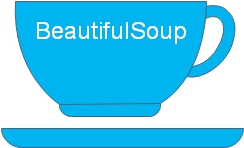BeautifulSoup for web scraping
 Beautifulsoup is a python library to extract data from HTML or XML files.
Beautifulsoup is a python library to extract data from HTML or XML files. To install this package with Anaconda run this line.
conda install -c anaconda beautiful-souppip install beautifulsoup4pip install lxmlGetting the content
Before using our library BeautifulSoup we need to collect the content of the webpage. First we need to send a request to get the content from a website. To do this we need requests library.Then we need the GET request to collect the details.
import requests
link = "https://www.plus2net.com/html_tutorial/html-canvas.php"
content = requests.get(link)
print(content.text)Creating a BeautifulSoup object
We will use the above code and then apply one BeautifulSoup object to it.from bs4 import BeautifulSoup
soup = BeautifulSoup(content.text, 'html.parser')html.parser. We can also use other options, like 'lxml' and 'html5lib' for different requirments.
Let us try to extract some common HTML tags
import requests
link = "https://www.plus2net.com/html_tutorial/html-canvas.php"
content = requests.get(link)
from bs4 import BeautifulSoup
soup = BeautifulSoup(content.text, 'html.parser')
print(soup.title) # gets title tag
print(soup.h1) # gets H1 tag
print(soup.h1.string)
#print(soup.title.parent) # full string within the parent tag
print(soup.title.parent.name)<title>Canvas html <canvas> tag to draw lines or graphics or animation in web page</canvas></title>
<h1 itemprop="headline"><canvas> HTML Canvas tag</h1>
<canvas> HTML Canvas tag
headh2_tags=soup.find_all('h2') # List of all h2 tags
h2_strings = [tag.string for tag in h2_tags] # remove the h2 tag and keep only string partcontent = """<html>
<head>
<title>Your title of the page here</title>
<META NAME='DESCRIPTION' CONTENT='my description '>
<META NAME='KEYWORDS' CONTENT='kw1,kw2,kw3'>
</head>
<body>
Hello <br>
Welcome to plus2net.com
</body>
</html>"""
from bs4 import BeautifulSoup
soup = BeautifulSoup(content, 'html.parser')
print(soup.title) # gets title
print(soup.h1) # gets H1 tag
print(soup.title.name) # name of the tag i.e title
print(soup.title.string)
print(soup.title.parent) # full string within the parent tag
print(soup.title.parent.name)<title>Your title of the page here</title>
None
title
Your title of the page here
<head>
<title>Your title of the page here</title>
<meta content="my description " name="DESCRIPTION"/>
<meta content="kw1,kw2,kw3" name="KEYWORDS"/>
</head>
headprint(soup.h2) # gets H2 tag
print(soup.h2.string) # print text associated with h2 tagprint(soup.meta['content']) # first meta tag, attribute content
print(soup.find_all('meta')[1]["content"]) # second meta tagmy description
kw1,kw2,kw3Getting title and keywords from YouTube vide
import requests
link = "https://youtu.be/SPw6SfN9beg"
content = requests.get(link)
from bs4 import BeautifulSoup
soup = BeautifulSoup(content.text, 'html.parser')
print(soup.title.string) # gets title tag
d =soup.find_all('meta')
print(d[4]['content']) # all keywordsTkinter frame to hold widgets and images with background colour border and managing layout - YouTube
Tkinter frame to hold multiple widgets, adding image to frame, background colour of the frame, border thickness of frame, frame border colour, border on focus, removing frame using forget(), grid_forget(), pack_forget(), adding multiple frames, delete and restore frames, creating frame using grid and pack layout, Image on label and frame, button on click event remove frame, button on click restore frameGetting all links from a web page
import requests
link="https://www.plus2net.com"
content = requests.get(link)
from bs4 import BeautifulSoup
soup = BeautifulSoup(content.text, 'html.parser')
my_links = []
for ln in soup.findAll('a'):
my_links.append(ln.get('href'))
print(my_links) Before scraping read the website’s legal use of data and avoid frequent request for data to website.
Collecting kyeword suggestions from Google
Subscribe to our YouTube Channel here
This article is written by plus2net.com team.
https://www.plus2net.com

 Python Video Tutorials
Python Video Tutorials